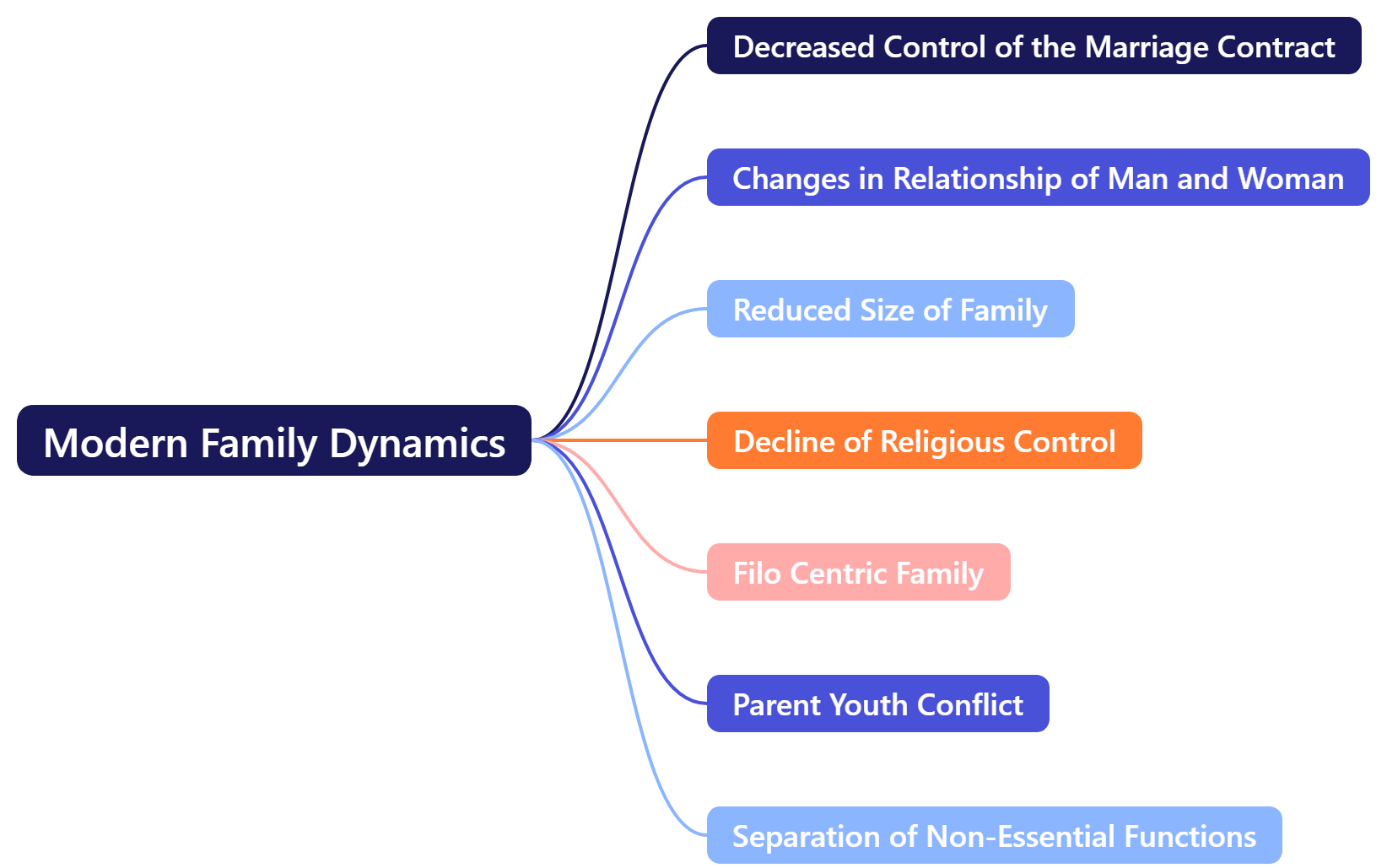Sociology: The significant trends in the modern family
(Relevant For Sociology Optional UPSC)

IntroductionFamily structures of some kind are found in every society. Pairing off into formal or informal marital relationships originated in hunter-gatherer groups to forge networks of cooperation beyond the immediate family. Intermarriage between groups, tribes, or clans was often political or strategic and resulted in reciprocal obligations between the two groups represented by the marital partners. Even so, marital dissolution was not a serious problem as the obligations resting on marital longevity were not particularly high.
(1) Decreased Control of the Marriage Contract:Marriage is the basis of family. In traditional family the marriage was settled by the parents. The marriage ceremony was based on the principle of male dominance and female obedience. In modern family people is less subject to the parental control regarding marital affairs. The marriage is now settled by the partners themselves. It is the choice of mate by mate usually preceded by courtship or falling in love. Today more stress is being laid on romantic love but love is no more sacramental now. Marriage also has become a civil contract rather than a religious sacrament. It can be dissolved easily at any time as it is settled by mutual consent of the partner. The authority of religion over the conditions of marriage has markedly declined. Divorce, desertion and separation are frequent occurrence in modern family where as it was rare phenomenon in traditional family. (2) Changes in Relationship of Man and Woman:In modern family the woman is not the devotee of man but an equal partner in life with equal rights. The husband does not dictate but only requests to the wife to do a task for him. She is now emancipated of the man’s slavery. She can divorce her husband as the husband can divorce her. Democratic ideas have provided equality and liberty to even women too. As a result women are not playing domestic role but also economic and political roles. They have now become property owners and business managers. They have right to vote and can actively participate in politics. They are now liberated from the chains of traditionalism and they are now able enough to move from kitchen to cabinet. They stand on an equal footing with men. Aggressive leaders of the women’s liberation movement have attacked the standard of morality. They are demanding more rights and liberty in the family, society as well as in the country. Due to the employment opportunity the women has become an earning member of the family, free to work in offices, factories, banks and schools etc. This economic independence has increased her status but has affected her attitude in the family as well as in society. (3) Reduced Size of Family:Due to industrialization and urbanisation the family size has been reduced and parents no longer desire more children rather develop a tendency to have a smaller family with the help of modern contraceptives. So the reproductive function of modern family has suffered a setback. However the very survival of the human race is based on reproduction. (4) Decline of Religious Control:The modern family is secular in attitude. The religious rites of the traditional family such as early prayer, yogya etc. are no longer performed in modern family. The elders do not read spiritual books such as Ramayana, Bhagabata rather they watch T.V. They are not interested to celebrate any religious festivals. Religious sentiments, beliefs and attitudes have come to be disassociated with the family. (5) Filo Centric Family:In the modern family the trend is towards the filo centric family, where the wishes of children determine the policy of the family. The social control activities of family over children have been lessened as physical punishment is rarely awarded to children. (6) Parent Youth Conflict:Inter-personal conflicts in the family are increasing. An unusual amount of conflict between parents and their adolescent children are taking place. Kingsley Davis says, “The stress and strain in our culture is symptomatic of the functionless instability of the modern small family.” (7) Separation of Non-Essential Functions:The modern family has given up many functions which were performed by the traditional family. Educational, procreation and care of sick persons functions have been shifted to certain external agencies like hospitals, maternity homes, nurseries kindergarten and schools etc. Apart from it the family is no longer an economic unit. More families rely upon prepared and manufactured goods for consumption. Movies, clubs, gambling centres provide recreation to people. People leave home for commercialized recreation centre, which has affected the cohesion of family. Protective functions of family have also declined. Families are no more the place of protection for the physically handicapped, mentally retarded, aged, diseased, infirm and insane people. Other agencies have taken over this function. But for the young children it continues to provide physical and emotional protection. Thus the family has been subjected to profound modifications of an economic, social and biological nature. The size and functions of the family have been reduced. It has suffered a change in regard to both its structure and functions. Its functions have been taken over by several specialized agencies. The modern family is more individualized and democratic where women enjoy a high prestige and position and children enjoy more independence as well. From an institution it has moved towards companionship. Many sociologists have expressed their grave concern regarding the rapid changes that are taking place in it. Some have said that “Family has gone to the digs.” While some others lamented that family is leading towards disorganization. But it would be more appropriate to say that it is merely seeking to adopt itself to changed conditions. |
To Read more topics like Sociology: The significant trends in the modern family in Public Posts, visit: www.triumphias.com/blogs
Read more Blogs:
Mentorship Programme @ IAS Skool | Ethics for UPSC Civil Services Examination | Triumph IAS



GOOD